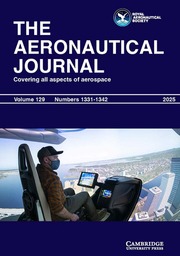No CrossRef data available.
Article contents
Design and optimisation of internal-external coupling flow for wide-speed-range airbreathing waverider
Published online by Cambridge University Press: 01 September 2025
Abstract
Airbreathing waveriders often use the fuselage forebody as the pre-compression surface of the inlet, which tends to encounter complex internal-external flow coupling issues. First, the osculating cone method is employed, and a wide-speed-range airbreathing waverider is designed by partitioning it into the waverider forebody, elongated body and waverider aft body, achieving full waverider characteristics. Next, the configuration is optimised to address the internal-external flow coupling issue. The calculations show that the optimised configuration improves the lift-to-drag ratio by more than 20% and the total pressure recovery coefficient by more than 30% in both operating conditions compared to the baseline configuration. Finally, data mining techniques are applied to analyse the data from the optimisation process. It reveals the interdependent relationship between the vehicle’s internal and external flow performance, with the cone shock wave angle and wing extension line length having the most significant impact on aerodynamic performance, thereby generating design knowledge. The content of this paper covers configuration design, optimisation and data mining. The entire process is highly generalisable and can serve as a reference for other aircraft configuration design optimisation tasks. The resulting design knowledge can also provide valuable insights for researchers in future airbreathing waverider designs.
Keywords
Information
- Type
- Research Article
- Information
- Copyright
- © The Author(s), 2025. Published by Cambridge University Press on behalf of Royal Aeronautical Society


